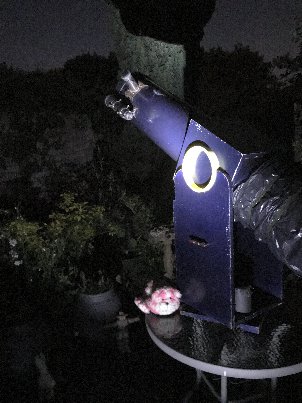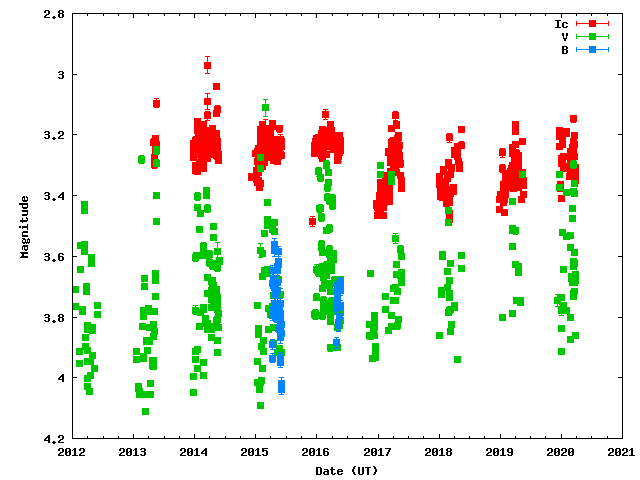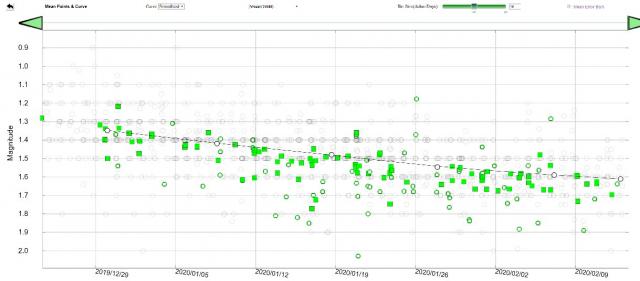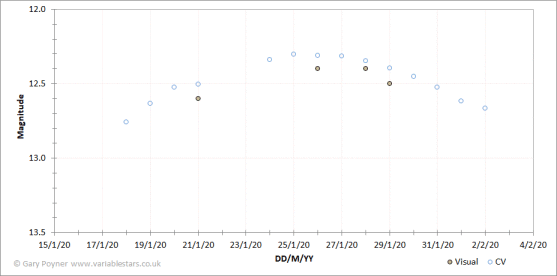Forum Replies Created
-
AuthorPosts
-
 Gary PoynerParticipant
Gary PoynerParticipantFurther to my #2 post above, our VSS director suggested I post a photo of my scope in PQ And mode. Well here it is. My trusty 30 year old battered 22cm dobby doing a balancing act on a table, but it does get me to view over the hedge. I often do this for stars low in the north which my 51cm in the observatory can’t get at. In the past it’s been on milk crates, house bricks etc. and even poked out of the bedroom window – much to my wifes’ disgust on a cold winters morning 🙂
The cat didn’t show up this morning, so this is one I made earlier…
Gary

 Gary PoynerParticipant
Gary PoynerParticipantHello Rob,
Good to see you’ve finally got to it after all these years! Quite something isn’t it!
Gary
 Gary PoynerParticipant
Gary PoynerParticipantThere is now a short and pretty basic PQ And page residing on the BAAVSS website https://britastro.org/vss/PQAnd.htm
Hopefully I’ll add to it as the outburst progresses, so if you have anything you’d like to share (spectrum, time series photometry etc. I’m not asking for much am I) then please send it to me and I’ll add it.
And please don’t forget to add your observations of PQ And to the BAAVSS database.
Gary
 Gary PoynerParticipant
Gary PoynerParticipantThe first pretty picture I see I’ll put on front of VSS web page. I’ve just put the 1988 light curve on there too.
Gary
 Gary PoynerParticipant
Gary PoynerParticipantHi James,
Well we only have the historic outburst to go on, which wasn’t that well covered. However looking at the light curve it faded by a magnitude in just 5 days or so, and then two weeks to lose a further magnitude.
UGWZ type stars (if it is indeed one of these) can do wonderful things once they have faded – like re-outbursting a number of times after the primary outburst. They don’t do this every time though, just to keep us on our toes.
It’s going to be very frustrating due to it’s poorly placed position, but must remain hopeful that someone will get some good photometry and or spectroscopy during this outburst – but I’m not holding my breath.
Gary
 Gary PoynerParticipant
Gary PoynerParticipantI’ve never waited 32 years to see a star for the second time before – but it was worth the wait. On 1988 March 28 I made my first observation of PQ And, detected by my fellow BAAVSS observer and friend Dave McAdam a week before. Tried from the BAA Winchester weekend at Kings Alfred’s college without luck on the 26 & 27, although the skies were very clear – no scopes about! My mag on the 28th was 11.6. By April 13 it had faded to mag 13.0 when I lost it in the NW evening sky.
Three decades later and here I am at 3am in the morning, balancing my trusty old 22cm dobby on a garden table, peering over the hedge to pick out this 10th mag dot low in the NE sky, and hoping the local cat doesn’t jump up, knock everything over and wake up the neighbours – and worse, my wife!!! I have to admit I was beginning to wonder if I’d ever see it again, yet there it was. Couldn’t sleep when I eventually got to bed – too excited. VS are brilliant things to observe.
Gary
 Gary PoynerParticipant
Gary PoynerParticipantHello Roy,
There is no formal way to join the VSS, as long as your interested in VS we’ll welcome you!
To submit observations to the database, you will need an observer code and login details. Have a read of this and it will advise how to go about it…
https://britastro.org/photdb/notes_submissions.php
I’ll leave it to one of the CCD observers to comment on your set-up, but it looks fine to me.
Don’t forget the VSS Circulars – free to everyone! https://britastro.org/vss/VSSC_archive.htm
Gary
 Gary PoynerParticipant
Gary PoynerParticipantHi James,
There were some problems with the VSS web site following the server upgrade, but I made some changes to several of the page links in the contents frame, and all is now well. I’ve had several people test all the links, with no problems reported.
I’ve also just tested the URL (britasro.org/vss/) and all seems to be well.
Gary
 Gary PoynerParticipant
Gary PoynerParticipantI wouldn’t be against a simpler Winchester, but I don’t think you could do it now. When I first started attending in the 1970’s amateur astronomy was much simpler (and some would argue, much more fun). There was a more ‘hands on’ approach, where someone might take a cardboard tube and a greasy shaving mirror and end up with a visual observation of some astronomical object, or perhaps construct an observatory from old pallets etc. (I helped a friend do this. The observatory lasted years!). The majority of conversations at Winchester (before the bar) were about what we saw through our instruments, and we didn’t need computers to locate these objects in the clear skies we sometimes had at the old King Alfred’s college. Yes indeed, those were the days! 🙂
Although I enjoy attending astronomical meetings they can and do get very ‘samey’. All high tech, expensive kit, satellites and professional astronomers etc. But perhaps that’s for another discussion.
Gary
 Gary PoynerParticipant
Gary PoynerParticipantAhh. Those were the days. Thanks for sharing Martin.
Gary
 Gary PoynerParticipant
Gary PoynerParticipantEggs’ceedingly decent of you Bill!
Probably just arriving at the college now (14.53 hrs) 🙁
Gary
 Gary PoynerParticipant
Gary PoynerParticipantPauline, what a very cruel posting on today of all days. You know how to twist the knife…
About now I would be saying a teary goodbye to my cats whilst my wife packs my Winchester bag. Then off to pick a few others up before heading down to bring some much needed warm Brummie cheer to the locals of the sleepy village of East Ilsley and the Crown and Horns pub in particular. Then off in convoy to Sparsholt to revel in my 43rd Winchester meeting. Instead, what am I doing this weekend? Scouring the dark, grimy back streets of Kingstanding in North Brum to find a dozen black market eggs.
Thanks Pauline – my old mate!
Gary
 Gary PoynerParticipant
Gary PoynerParticipantHi Alan,
Well this is the first time I’ve seen a plot of delta UMa myself. VSX says the variability is of unspecified type, but this link suggests a possible EB http://liber.onu.edu.ua/pdf/astro/all/OAP_9/000_pdf/bryukh.pdf
It’s quite interesting that the amplitude of the fades vary from one fade to the next. Be nice to see a much longer plot. My eyes are possibly seeing a secondary wave on that light curve.
Gary
 Gary PoynerParticipant
Gary PoynerParticipantThis is from KWS (Kamogata/Kiso/Kyoto Wide-field Survey). delta UMa also has a NSV designation (NSV 5513)
Gary

 Gary PoynerParticipant
Gary PoynerParticipantThis is a 10d mean visual and V-band light curve for Betelgeuse since the start of the year – taken from the AAVSO light curve generator. The trend is still slightly downwards, but perhaps levelling out.
Gary

 Gary PoynerParticipant
Gary PoynerParticipant
Slow decline has been ongoing since Jan 28, following a short flat maximum. Here is my plot up to and including Feb 02.073 UT
Gary
 Gary PoynerParticipant
Gary PoynerParticipantEnjoyed the live streaming yesterday. Many thanks for making this available. One comment though – the volume was very low.
Gary
 Gary PoynerParticipant
Gary PoynerParticipantBeen having a ‘play’ with SLOOH over the past couple of weeks, and managed this image of C/2017 T2 on Jan 4.812 UT with ‘Canary 1’ – (0.5-m). Not keen on displaying images I haven’t taken (I refuse to spend time processing images), but I quite liked this one.
Gary
Gary
 Gary PoynerParticipant
Gary PoynerParticipantHave to say I was slightly underwhelmed at T2 on the evening of Jan 20. Although overhead, the background sky is always too bright to appreciate Comets from Birmingham, even fairly bright ones like this. In the 51cm with a 10mm Ethos I could just discern the tail. Ten minutes later, and a degree or so away across the open cluster, I was seeing close to mag 16 in a variable star field with the same eyepiece. My first Comet was Bennett in 1970, and I have loved observing them ever since. However light pollution has virtually ended this aspect of visual observing enjoyment for me.
Gary
 Gary PoynerParticipant
Gary PoynerParticipantThe AAVSO have now added this supernova to VSX, so you can now upload your observations to the AID. There is also a sequence available if you plot a chart using VSP http://www.aavso.org/vsp
May have reached maximum – 12.504CV on Jan 21.079 UT.
Gary
-
AuthorPosts
